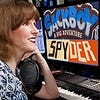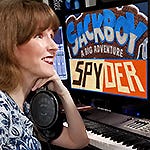
Featured Blog | This community-written post highlights the best of what the game industry has to offer. Read more like it on the Game Developer Blogs or learn how to Submit Your Own Blog Post
AES Convention: What's New on the Show Floor
Audio encoding for VR and new audio software releases were among the technologies showcased this weekend on the expo floor of the Audio Engineering Society convention in NYC. As an AES speaker this year, I checked out what was cool in game audio at AES.

This past weekend, the Audio Engineering Society held its annual North American convention in the Jacob Javits Center in New York City. I was participating as an AES speaker, but I also knew that AES includes an exhibit floor packed with the best professional audio equipment from all the top manufacturers, and I didn't want to miss that! So, in between my game audio panel presentation on Saturday, and the Sunday tutorial talk I gave on the music system of the LittleBigPlanet franchise, I had the pleasure of searching the show floor for what's new and interesting in audio tech. Here are some of the attractions that seemed most interesting for game audio folks:
 One of the most interesting technologies on display at AES this year was Fraunhofer Cingo - an audio encoding technology developed specifically to enable mobile devices to deliver immersive sound for movies, games and virtual reality. Cingo was developed by the institute responsible for the MP3 audio coding format. According to Fraunhofer, the Cingo technology "supports rendering of 3D audio content with formats that add a height dimension to the sound image, such as 9.1, 11.1 or other channel combinations."
One of the most interesting technologies on display at AES this year was Fraunhofer Cingo - an audio encoding technology developed specifically to enable mobile devices to deliver immersive sound for movies, games and virtual reality. Cingo was developed by the institute responsible for the MP3 audio coding format. According to Fraunhofer, the Cingo technology "supports rendering of 3D audio content with formats that add a height dimension to the sound image, such as 9.1, 11.1 or other channel combinations."
This enables mobile devices to emulate "the enveloping sound of movies, games or any other virtual environment." While I was there, Fraunhofer rep Jennifer Utley gave me the chance to demo the Cingo technology using the Gear VR headset, which turns Samsung mobile phones into portable virtual reality systems. The sound generated by Cingo did have an awesome sense of spatial depth that increased immersion, although I didn't personally notice the height dimension in the spatial positioning. Nevertheless, it was pretty nifty! Check out this video from Fraunhofer, describing the Cingo technology:

Firelight Technologies was on hand at AES this year to show off their newest update of FMOD Studio, the audio middleware that enables interactive audio implementation using a GUI similar to standard audio production software. Version 1.07 of FMOD (officially released October 12th) offers several useful new features, including scripting functionality, content sharing between projects, faster project loading times, improvements in the graphical interface, and two new plugins: 3Dception (enabling virtual 3D audio over headphones for virtual reality experiences) and AudioMotors (for the emulation of vehicle engine noise).
 Yamaha / Steinberg were proudly showing off the compatibility between their Nuendo 7 audio post software and the game audio middleware application Wwise. While this functionality was previously demonstrated at GDC 2015, Nuendo 7 was not officially released until late June of this year, so AES was a great opportunity to get hands-on time with the final released version of the software.
Yamaha / Steinberg were proudly showing off the compatibility between their Nuendo 7 audio post software and the game audio middleware application Wwise. While this functionality was previously demonstrated at GDC 2015, Nuendo 7 was not officially released until late June of this year, so AES was a great opportunity to get hands-on time with the final released version of the software.
At the Yamaha booth, I had a chance to discuss Nuendo 7 with David Lees, Nuage District Manager at Yamaha. In addition to its Wwise compatibility, the Nuendo 7 software also offers ease of batch file naming with flexibility in naming schemes, and enhanced functions for rendering large numbers of audio and MIDI files.
(Update 11/5/15: Since many of us are long-time Pro Tools users, I contacted David Lees with a question about Nuendo 7's compatibility with Pro Tools. David Lees let me know that Pro Tools session data can be exchanged back and forth easily with Nuendo 7 using files in Advanced Authoring Format (AAF). Also, David added that "Nuendo 7 allows you to assign PT keyboard shortcuts to Nuendo with one mouse click, standardizing navigation and minimizing the learning curve." David then let me know that "Nuendo 7 can be pointed to any core audio or ASIO driver, which means it can use the existing IO in the studio." All of these are interesting points to consider. In an ideal world, Pro Tools would have direct compatibility with Wwise. Until that occurs, some Pro Tools users among us may think seriously about adding Nuendo 7 to our studios.)
Here's a video that discusses Nuendo 7's compatibility with Wwise:
In addition, Nuendo 7 includes a Pro Sound Effects Library with 1.5 GB of royalty free sound effects. And speaking of sound effects...
 The Hollywood Edge / Sound Ideas library of sound effects was on hand to display hot products in their famous sound effects collections, including three recent releases:
The Hollywood Edge / Sound Ideas library of sound effects was on hand to display hot products in their famous sound effects collections, including three recent releases:
The Voice Kit and Wind collections are somewhat comprehensive specialized collections focusing on narrowly defined sound categories and released in only the last few months. The Communications collection dates from 2014, but this collection might particularly interest game composers and sound designers. Featuring all sorts of telemetry, radio, and space communications noises, these sounds might potentially fit well in a hi-tech or futuristic soundscape. Here's a video that demonstrates the Communications collection:
 Pro Tools had a large booth at AES this year, and a reason for excitement. The latest update of their software had been freshly announced during the convention, which meant that their booth was one of the busiest and most popular on the show floor this year. While at AES, I had a chance to discuss the Pro Tools update with Jeremiah Ellison, a pro audio solutions specialist at Avid. Pro Tools 12.3 includes several new functions: Commit Track, MIDI Commit, Clip Transparency and Batch Fades. Here's a video that shows these new functions:
Pro Tools had a large booth at AES this year, and a reason for excitement. The latest update of their software had been freshly announced during the convention, which meant that their booth was one of the busiest and most popular on the show floor this year. While at AES, I had a chance to discuss the Pro Tools update with Jeremiah Ellison, a pro audio solutions specialist at Avid. Pro Tools 12.3 includes several new functions: Commit Track, MIDI Commit, Clip Transparency and Batch Fades. Here's a video that shows these new functions:
So there you have some of the highlights of the AES show floor this year! It was a fascinating convention, with tons of interesting tutorial sessions. Audio recordings from the conference portion of the show are now available through the AES web site.
 Winifred Phillips is an award-winning game music composer whose most recent project is the triple-A first person shooter Homefront: The Revolution. Her other credits include five of the most famous and popular franchises in video gaming: Assassin’s Creed, LittleBigPlanet, Total War, God of War, and The Sims. She is the author of the award-winning bestseller A COMPOSER'S GUIDE TO GAME MUSIC, published by the Massachusetts Institute of Technology Press. As a VR game music expert, she writes frequently on the future of music in virtual reality video games.
Winifred Phillips is an award-winning game music composer whose most recent project is the triple-A first person shooter Homefront: The Revolution. Her other credits include five of the most famous and popular franchises in video gaming: Assassin’s Creed, LittleBigPlanet, Total War, God of War, and The Sims. She is the author of the award-winning bestseller A COMPOSER'S GUIDE TO GAME MUSIC, published by the Massachusetts Institute of Technology Press. As a VR game music expert, she writes frequently on the future of music in virtual reality video games.
Follow her on Twitter @winphillips.
Read more about:
Featured BlogsAbout the Author(s)
You May Also Like







.jpeg?width=700&auto=webp&quality=80&disable=upscale)








